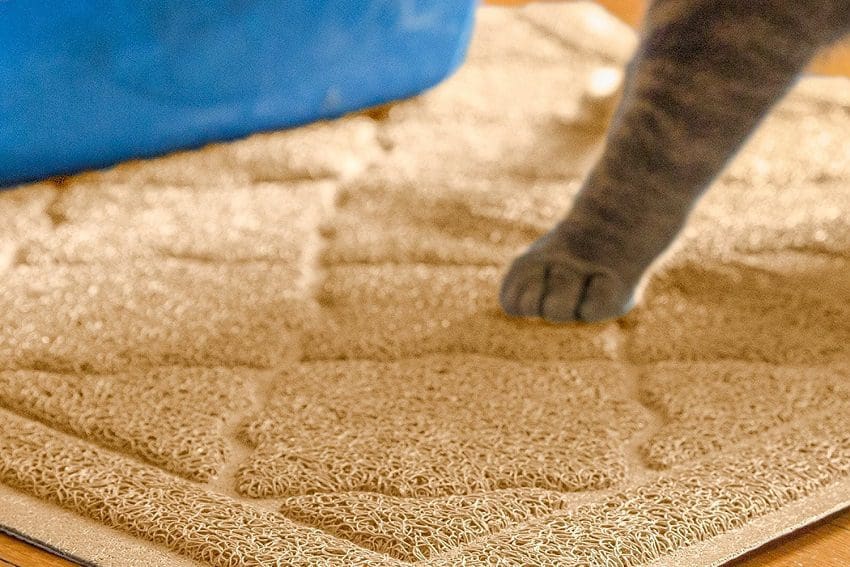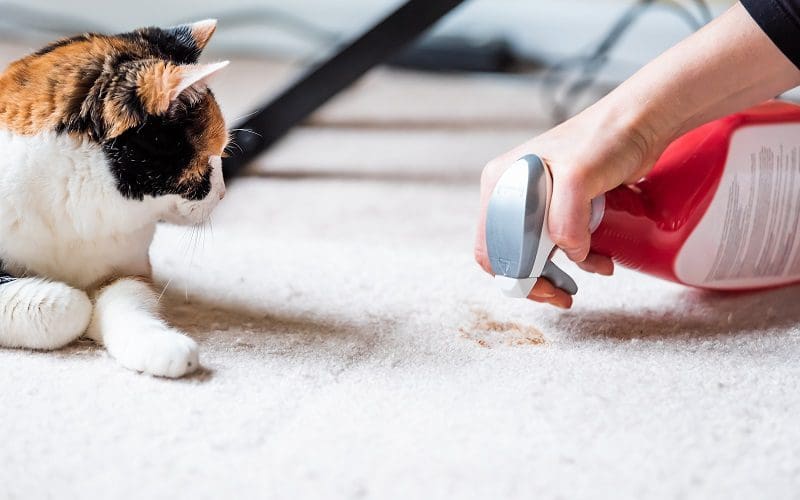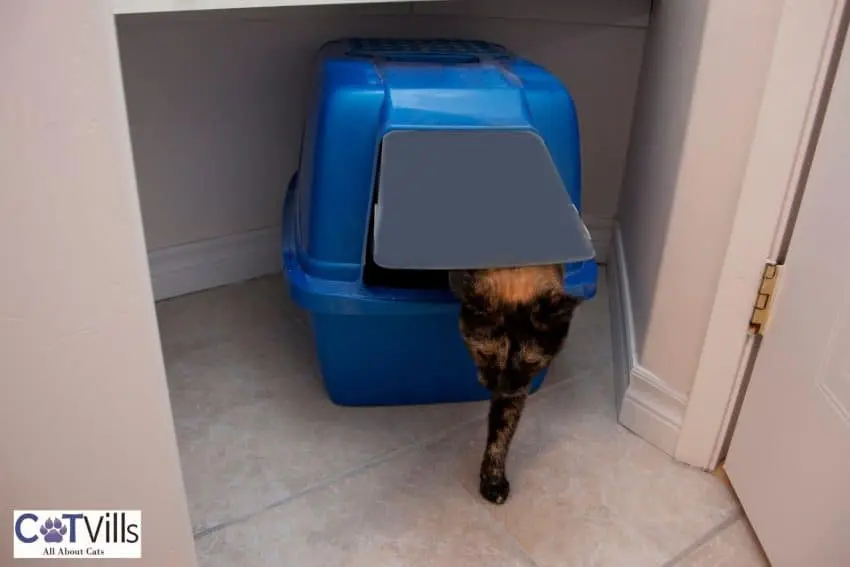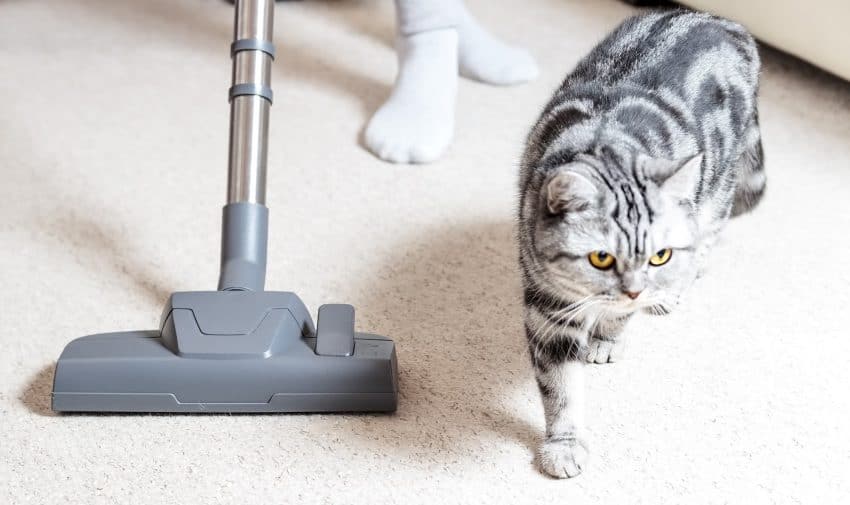Last Updated: 1 year ago
Learning how to train a cat to use a litter box can be a daunting task, but it doesn’t have to be! With the right tools and techniques, you can learn how to potty train cats easily.
It can be a great way to ensure your cat is comfortable and happy in its home environment, as well as reduce mess and odors.
Cat owners know how important it is to keep their homes clean and free of odors.
Basic Steps In Cat Potty Training
1. Choosing The Right Cat Litter Box

The first step in litter box training is providing an appropriate litter box for your cat.
The size of the box should be big enough so that they can comfortably move around inside without feeling cramped or confined.
It should also have low sides so they can easily climb in and out of the box when needed.
Make sure there are no obstacles near the entrance or exit, as these could block their access or cause them discomfort when entering or exiting the box.
2. Choosing The Right Cat Litter

There are many different types available, such as clumping litter or natural wood pellets. Just make sure whatever type you choose doesn’t contain any fragrances or chemicals that could be irritating to sensitive noses.
You should also keep an eye out for signs of allergies like sneezing or coughing after coming into contact with certain types of litter before making a purchase decision.
The next step is to fill the litter box with an unscented clumping type of cat litter (avoid scented litters as these may deter some cats).
Place a few pieces of used cat litter from another area into the new one so that they become familiar with its scent before using it themselves.
3. Encourage Your Kitty

Place a small rug next to their new bathroom spot, as this will give them something soft and comfortable on which to stand while doing their business.
Once everything is set up properly, encourage good behavior by rewarding them every time they use their new bathroom spot correctly (with treats or verbal praise).
Over time, this positive reinforcement will teach them where exactly they need to go when nature calls!
Cleaning out dirty boxes regularly will ensure that odors aren’t lingering around, which might discourage them from wanting to go back again later on down the line.
4. Deal With Accidents Calmly

If there are litter box problems or accidents, simply clean up any messes quickly and thoroughly.
Never punish them for making mistakes, as this could lead to further issues down the line.
Punishment could result in anxiety-related behaviors like urinating outside of their designated area.
At times, litter box training can be difficult. But with patience and understanding, most cats eventually learn how to use their designated areas appropriately.
How To Prepare And Choose Cat Litter And LItter Box
Choosing the right litter and box for your cat is essential to learning how to potty train cats.
Here are some tips on how to choose the right litter and litter box for your feline friend and advice on maintaining it.
1. Cat Litter Box Types And Size

There are many different types of litter boxes available on the market.
The most common type is the covered litter box. Covered litter boxes offer privacy for your cat and help contain the litter.
However, some cats prefer an uncovered litter box. If you are not sure which type of litter box your cat would prefer, you can try both and see which one she uses more.
The size of the litter box is also important. It should be big enough for your cat to move around in and turn around easily. If the litter box is too small, your cat may not be able to use it properly.
2. Location
The location of the litter box is also important. Some cats prefer to have their litter box in their own room.
Cats prefer peace and quiet when using their bathroom facilities, so try to place the box away from busy areas of your home, such as near doorways or high-traffic areas where people come through often.
This will give them more privacy while they go about their business without feeling disturbed by noise or activity going on around them.
Cat owners may prefer to have it in the laundry room or in the garage.
But make sure that your cat prefers it in these locations.
3. Choose a Low Dust Litter

Cats don’t like breathing in dust particles when they use their litter boxes, so opt for a low-dust option that won’t irritate them or make them sneeze.
There are many different types of litter available on the market. The most common type is clumping litter.
Clumping litter is absorbent and clumps when it gets wet. This makes it easy to scoop out the waste.
However, some cats prefer to use other types of litter, such as pine pellets or corn cob litter.
If you are not sure which type of litter your cat would prefer, you can try a few different types and see which one she uses more.
4. Litter Box Liner, Scooper And Mat
Litter box liners are not necessary, but they can help to keep the litter box clean.
Liners are available in different materials, such as plastic or paper. If you use a liner, be sure to change it often.
A litter box scooper is a tool that is used to scoop out the waste from the litter box.
Scoopers are available in different sizes and shapes. Be sure to get a scooper that is the right size for your litter box.
A litter box mat is a mat that goes under the litter box. It helps to keep the litter box clean and to catch any litter that is tracked out of the box.
Dealing With Setbacks During Potty Training

Litter box training for your cat can be a difficult and frustrating process, but it doesn’t have to be. With patience and consistency, you can help your cat learn the ropes of using the litter box in no time.
Even with all of your best efforts, there may still be some litter box problems along the way. The most important thing to remember when dealing with potty training setbacks is to remain patient and consistent.
Punishing or scolding your cat will only make them more stressed out and less likely to use the litter box in the future.
Instead, focus on cleaning up any messes that occur quickly so that they don’t become associated with certain areas of your home as “potty spots” for your pet.
If you notice that after successfully using their litter box for a while, accidents start happening again, this could mean that something else is going on, such as stress or illness.
Make sure to consult with a veterinarian if this happens so they can rule out any medical causes before taking further action regarding potty training issues.
Provide plenty of clean litter boxes around different locations in your home so that it’s easy for them to access one whenever needed!
This will also give them more options if one area becomes too dirty or smelly for their liking—cats are notoriously picky about where they do their business!
FAQ
How Long Does It Take To Train A Cat To Use A Litter Box?
Training a cat to use a litter box is relatively easy and can be done in as little as two weeks. Start by placing the litter box in an area that your cat frequents, such as near their food or bedding.
Place some of their feces inside the box so they become familiar with it. Then, every time you see them using the floor instead of the litter box, gently place them inside and reward them with treats when they use it correctly.
With consistent reinforcement, most cats will learn to use the litter box within two weeks or less.
How Do I Get My Cat to Use the Litter Box?
Establishing a litter box routine is key to getting your cat to use the litter box. Start by placing the litter box in an area that’s easily accessible for your cat, and make sure it’s not too close to their food or water bowls.
When you first introduce them to the litter box, place them inside it and gently scratch around in the litter with your fingers so they can get used to the feeling. Once they are comfortable, start encouraging them every time they use it by giving them treats or verbal praise.
Make sure you clean out any waste regularly, as cats prefer a clean environment when using their boxes. With patience and consistency, your cat will soon learn how to properly use their litter box!
Do Kittens Need To Be Trained To Use The Litter Box?
Yes, kittens need to be trained to use the litter box. This is an important part of cat ownership and should not be overlooked. To begin training your kitten, start by introducing them to a litter box filled with their preferred type of litter.
Place the box in a quiet area away from any other pets or distractions. Encourage your kitten to use the litter box by placing them inside it after meals and when they wake up from naps.
Praise them when they successfully use it and provide rewards like treats or toys for good behavior. With patience and consistency, you can help your kitten learn how to properly use the litter box!
What Is the Fastest Way to Litter Train a Kitten?
Litter training a kitten is relatively easy and can be done in just a few steps. First, choose an appropriate litter box that your kitten can easily access. Place the litter box in a quiet area of your home, away from any loud noises or distractions.
Introduce your kitten to the litter box by placing them inside it with their paws and showing them how to scratch around in the litter. Praise them when they use it correctly and clean up any messes quickly so they don’t associate the area with going to the bathroom.
Lastly, provide plenty of positive reinforcement for using the litter box correctly and keep it consistently clean for the best results!
Conclusion
Learning how to potty train a cat is not an easy task, but it can be done with patience and consistency.
With the right preparation, knowledge of the basics, and advanced tips for success, you can successfully potty train your cat.
Remember to remain patient during setbacks and keep up with consistent reinforcement of good behavior.
With these steps in mind, you should have no problem potty training your cat.
